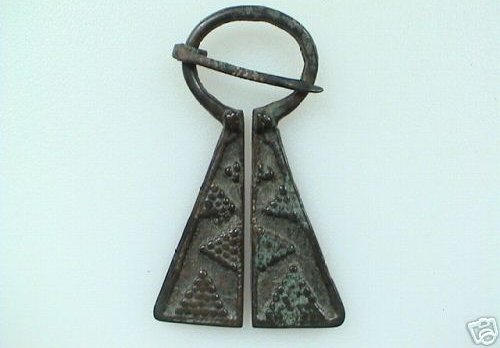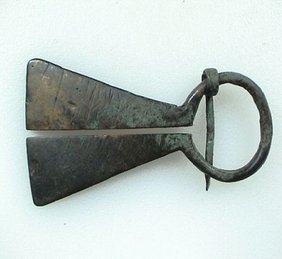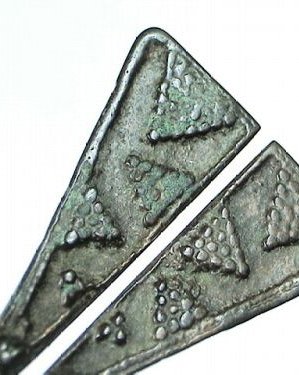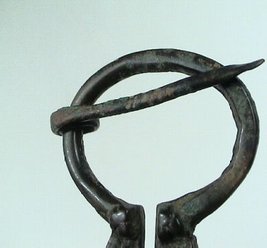A 'Baltic viking' fibula brooch and what it turned out to be.
A more common type of viking fibula brooch, found area Lake Ladoga, northwestern part present Russia.
It must have been in 2006 that I bought this brooch on Ebay. What did I know? It was found 'near Lake Ladoga', that mysterious - till this date to me - place in the far wild in northwestern Russia. Some 15 years afterwards, someone on www.academia.edu pointed out to me that these type of brooches aren't 'Baltic' let alone 'Viking' at all.
There is an very interesting article on http://www.medieval-baltic.us/syulgam.pdf named “The mysterious “Omega” brooches”. Within is stated that ‘Finds from the Staraya Ladoga in the early medieval period, even when carefully excavated, ‘are problematic to determine the origins of the deceased’. Of course, the person who sold this brooch on Ebay might have an idea of it being of Viking (better: Scandinavian) origin as tot he triangular dotted elements involved and artificially familiar with the history of the area, thinking that all objects being found around Staraya Ladoga are from Viking origin.
The style of the jewellry, already found over a century ago, point to an origin far tot he south in the modern-day republic of Mordovia.
The so called ‘granulated’ style is dated earliest tot the 13th century, latest tot the 16th century. So, centuries beyond the Viking period. These articles encourages me to persist in my message to be cautious and self researching when an object is described as Viking. It is still being sold as so, in origin or as a copy to re-enactors.
Although its categorizing under 'artefacts with a decoration and/or art style wich are found among the Slavs, Balts-Finns and Finno-Ugrian tribes in the time the vikings lived' is obsolete and wrong at all, I let this page excist, enabling visitors of this website to read this and get to know the proper origin and date for these kind of brooches, wich are 'all over the place' still are being sold as 'viking'. (Thomas Kamphuis, July 28th 2021).
Well. I could have been with these stones until after dark, but as my wife wanted to travel on.. well.. I see you again, some day, hogback stones from Gosforth. And if you happen to be there one day, do not forget that monument on the outside...
Further on with the Cumbrian hogbacktour !
In - yes, luckily again in - St. Peter's church in Heysham, there is a truly beautiful hogback stone. The guide told us, it had been studyied by Thor Ewing, a writer, in 2000. in 'Understanding the Heysham hogback' A tenth century sculpted stone monument and its context (link), Thor Ewing tells in detail what he dicovered on the both sides of this hogback stone.
Just being brought in the church as late as the 1970's accompanied with some protest here and there among the church visitors, considered as being a token of old paganism, it had been remarkably nice preserved, and a lot of detail can be seen, still. Truly worthwile a visit.
I had a small debate with the guide in the church if the - zoomorphic, in my opinion - faces on the sides were lions (or hippo's). The guide doubted if the vikings could have known about lions. Well I guess so, concerning the runes on the Ancient Greek lion statue at the Arsenal, Venice. For example. Vikings did travel south..
But when he told me he was doubting the vikings 'discovered' (as the native inhabitants were of course, in the first place) America before Columbus, I decided to rest my case..
One has to know when to start and to end a conversation ..
Just discovered the book in a bookstore written by Geoff Holder - The guide to the mysterious Lake District, I knew there had to be another hogback stone in Lowther, St. Micheal's Church. With a promising image described in the text of 'a naval and a land-based force of shield-bearing vikings above a fish and what might be a coiled sea serpent. On the reverse is a row of female figures with snakes, possibly a representation of the hideous hag Hel'. Wow. If that did not sound as a true pagan promised land ..
Not complaing too much after all we have seen, this visit was the dissapointing one of them all. But if you wife states 'I am happy to have seen them' and I am answering 'Measuring is knowing' and the even more obligate verb 'handling 'if we did not see it at all, we wouldn't have known anything at all of how they were looking' the glass was again half full, at the last day of our journey..
The hogback stone appeared to be just being tolerated within the entrance segment part of the church. As something you never use anymore but you do not throw away - entirely. That sort of feeling emerged when seeing this hogback asylum seekers.. Bed, bath and bread, ás we say in Dutch, but no luxury at all and standing on some outcuts of wood, you would balance the table with at home..
Come on, St. Micheal's Church.. care a bit more of your 'children' !
This hogback stone was moved in the church in 1907. Hogback stones layed partially buried in the churchyard before it was dug up and moved into the church.
The promising depiction of a longship - as certainly can be seen after some studying - see http://vikingminds.co.uk/pages/longship
we have missed !
The stone itself is (157 x 50 x 30 cm) and very worn.
The hogback stones in Cumbria - very diverse in quality, but everyone worth a visit ! Especially on a gloomy day in late October ...
The churches to visit - see photos of resp. St. Andrew's church in Penrith, St. Mary's church in Gosforth, St. Peter's church in Heysham and St. Micheal's church in Lowther.
Did I miss out on another one in Cumbria ? Let me know !
In a next blog I will take you to four - still remaining utterly mysterious- statues 'guarding' the graveyard of St. Andrew's church in Dacre..
For the last blog of October 9th see this link.
References: (as always, links to where the books can be ordered are attached).
Edwards, B.J.N. Vikings in North West England - The artifacts (1998);
Emery, Gordon, CURIOUS CUMBRIA, The Lake District & Beyond: A celebration of Cumbria (2023)
Ewing, T. 'Understanding the Heysham hogback' A tenth century sculpted stone monument and its context ;
Hall, R. Viking Age archaeology in Britain and Ireland (first printed 1990, reprinted with amendments in 1995);
Holder, G. The guide to the mysterious Lake District (2009)
possibly also (as there within the part of Cumbria dealing with Carlisle, the Eden Valley, Barrow-in-Furness, Whitehaven and the west coast is being dealed with)
Holder, G. Paranormal Cumbria (2010)
http://vikingminds.co.uk/pages/longship



